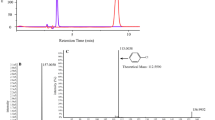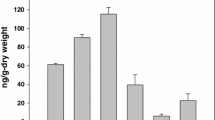Abstract
Strain B51 capable of degrading polychlorinated biphenyls (PCB) was isolated from soil contaminated with wastes from the chemical industry. Based on its morphological and chemotaxonomic characteristics, the strain was identified as a Microbacterium sp. Experiments with washed cells showed that strain B51 is able to degrade ortho- and para-substituted mono-, di-, and trichlorinated biphenyls (MCB, DCB, and TCB, respectively). Unlike the known PCB degraders, Microbacterium sp. B51 is able to oxidize the ortho-chlorinated ring of 2,2′-DCB and 2,4′-DCB and the para-chlorinated ring of 4.4′-DCB. The degradation of 2,4′-DCB and 4,4′-DCB was associated with the accumulation of 4-chlorobenzoic acid (4-CBA) in the medium in amounts comprising 80–90% of the theoretical yield. The strain was able to utilize 2-MCB, 2,2′-DCB, and their intermediate 2-CBA and to oxidize the mono(ortho)-chlorinated ring of 2,4,2′-TCB and the di(ortho-para)-chlorinated ring of 2,4,4′-TCB. A mixed culture of Microbacterium sp. B51 and the 4-CBA-degrading bacterium Arthrobacter sp. H5 was found to grow well on 1 g/l 2,4′-DCB as the sole source of carbon and energy.
Similar content being viewed by others
REFERENCES
Fedorov, L.A., Dioksiny kak ecologicheskaya opasnost': retrospectiva i perspektivy (Dioxins as an Ecological Hazard: Retrospection and Prospects), Moscow: Nauka, 1993.
Abramowicz, D.A. and Daniel, A., Aerobic and Anaerobic PCB Biodegradation in the Environment, Environ. Health Perspect., 1995, vol. 103, pp. 97-104.
Unterman, R., A History of PCB Biodegradation, Bioremediation: Principles and Applications, Crawford, R.L. and Crawford, D.L., Eds., 1996, pp. 209-253.
Maltseva, O.V., Tsoi, T.V., Quensen III, J.F., Fucuda, M., and Tiedje, J.M., Degradation of Anaerobic Reductive Dechlorination Products of Aroclor 1242 by Four Aerobic Bacteria, Biodegradation, 1999, vol. 10, pp. 363-371.
Fava, F., Di Gioia, D., Cinti, S., Marchetti, L., and Quattroni, G., Degradation and Dechlorination of Low-chlorinated Biphenyls by a Three-membered Bacterial Coculture, Appl. Microbiol. Biotechnol., 1994, vol. 41, pp. 117-123.
Erickson, B.D. and Mondello, F.J., Enhanced Biodegradation of Polychlorinated Biphenyl after Site-directed Mutagenesis of a Biphenyl Dioxygenase Gene, Appl. Environ. Microbiol., 1993, vol. 59, pp. 3858-3862.
Seeger, M., Zielinski, M., Timmis, K.N., and Hofer, B., Regiospecificity of Dioxygenation of Di-to Pentachlorobiphenyls and Their Degradation to Chlorobenzoates by the bph-encoded Catabolic Pathway of Burkholderia sp. Strain LB400, Appl. Environ. Microbiol., 1999, vol. 65, pp. 3614-3621.
Kimura, N., Nishi, A., Goto, M., and Furukawa, K., Functional Analyses of a Variety of Chimeric Dioxygenases Constructed from Two Biphenyl Dioxygenases That Are Similar Structurally but Different Functionally, J. Bacteriol., 1997, vol. 179, pp. 3936-3943.
Vaillancourt, F.H., Labbe, G., Droouin, N.M., Fortin, P.D., and Eltis, L.D., The Mechanism-based Inactivation of 2,3-Dihydroxybiphenyl 1,2-Dioxygenase by Catecholic Substrates, J. Biol. Chem., 2002, vol. 277, pp. 2019-2027.
Seah, S.Y.K., Labbe, G., Kaschebek, S.R., Reifenrath, F., Reineke, W., and Eltis, L.D., Comparative specificities of Two Evolutionarily Divergent Hydrolases Involved in Microbial Degradation of Polychlorinated Biphenyls, J. Bacteriol., 2001, vol. 183, pp. 1511-1516.
Kim, S. and Picardal, F.W., Microbial Growth on Dichlorobiphenyls Chlorinated on Both Rings As a Sole Carbon and Energy Source, Appl. Environ. Microbiol., 2001, vol. 64, pp. 1953-1955.
Potrawfke, T., Lohnert, T.-H., Timmis, K.N., and Wittich, R.-M., Mineralization of Low-chlorinated Biphenyls by Burkholderia sp. Strain LB400 and by a Two-membered Consortium upon Directed Interspecies Transfer of Chlorocatechol Pathway Genes, Appl. Microbiol. Biotechnol., 1998, vol. 50, pp. 440-446.
Zaitsev, G.M. and Karasevich, Yu.N., Utilization of 4-Chlorobenzoic Acid by an Arthrobacter globiformis Strain, Mikrobiologiya, 1981, vol. 50, pp. 35-40.
Manual of Methods for General Bacteriology, Gerhardt, P. et al., Eds., Washington: Am. Soc. Microbiol., 1981. Translated under the title Metody obshchei bakteriologii, Moscow: Mir, 1983–1984, vol. 1–3.
Evtushenko, L.I., Dorofeeva, L.V., Subbotin, S.A., Cole, J.R., and Tiedje, J.M., Leifsonia poae gen. nov., sp. nov., Isolated from Nematode Galls on Poa annua and Reclassification of “Corynebacterium aquaticum” Leifson 1962 as Leifsonia aquatica (ex Leifson 1962) gen. nov., nom. rev., comb. nov. and Clavibacter xyli Davis et al. 1984 with Two Subspecies as Leifsonia xyli (Davis et al. 1984) gen. nov., comb. nov., Int. J. Syst. Evol. Microbiol., 2000, vol. 50, pp. 371-380.
Rybkina, D.O., Plotnikova, E.G., and Demakov, V.A., Degradation of Chlorobenzoates by Soil Bacteria, Ob. Nauchn. Zh., 2003, no. 1, pp. 73-82.
Takeuchi, M. and Hatano, K., Union of the Genera Microbacterium Orla-Jensen and Aureobacterium Collins et al. in a Redefined Genus Microbacterium, Int. J. Syst. Bacteriol., 1998, vol. 48, pp. 739-747.
Havel, J. and Reineke, W., Total Degradation of Various Chlorobiphenyls by Cocultures and In Vivo Constructed Hybrid Pseudomonads, FEMS Microbiol. Lett., 1991, vol. 78, pp. 163-170.
Hrywna, Y., Tsoi, T.V., Maltseva, O.V., and Tiedje, J.M., Construction and Characterization of Recombinant Bacteria That Grow on ortho-and para-substituted Chlorobiphenyls, Appl. Environ. Microbiol., 1999, vol. 65, pp. 2163-2169.
Author information
Authors and Affiliations
Rights and permissions
About this article
Cite this article
Rybkina, D.O., Plotnikova, E.G., Dorofeeva, L.V. et al. A New Aerobic Gram-Positive Bacterium with a Unique Ability to Degrade ortho- and para-chlorinated Biphenyls. Microbiology 72, 672–677 (2003). https://doi.org/10.1023/B:MICI.0000008367.24540.6c
Issue Date:
DOI: https://doi.org/10.1023/B:MICI.0000008367.24540.6c




